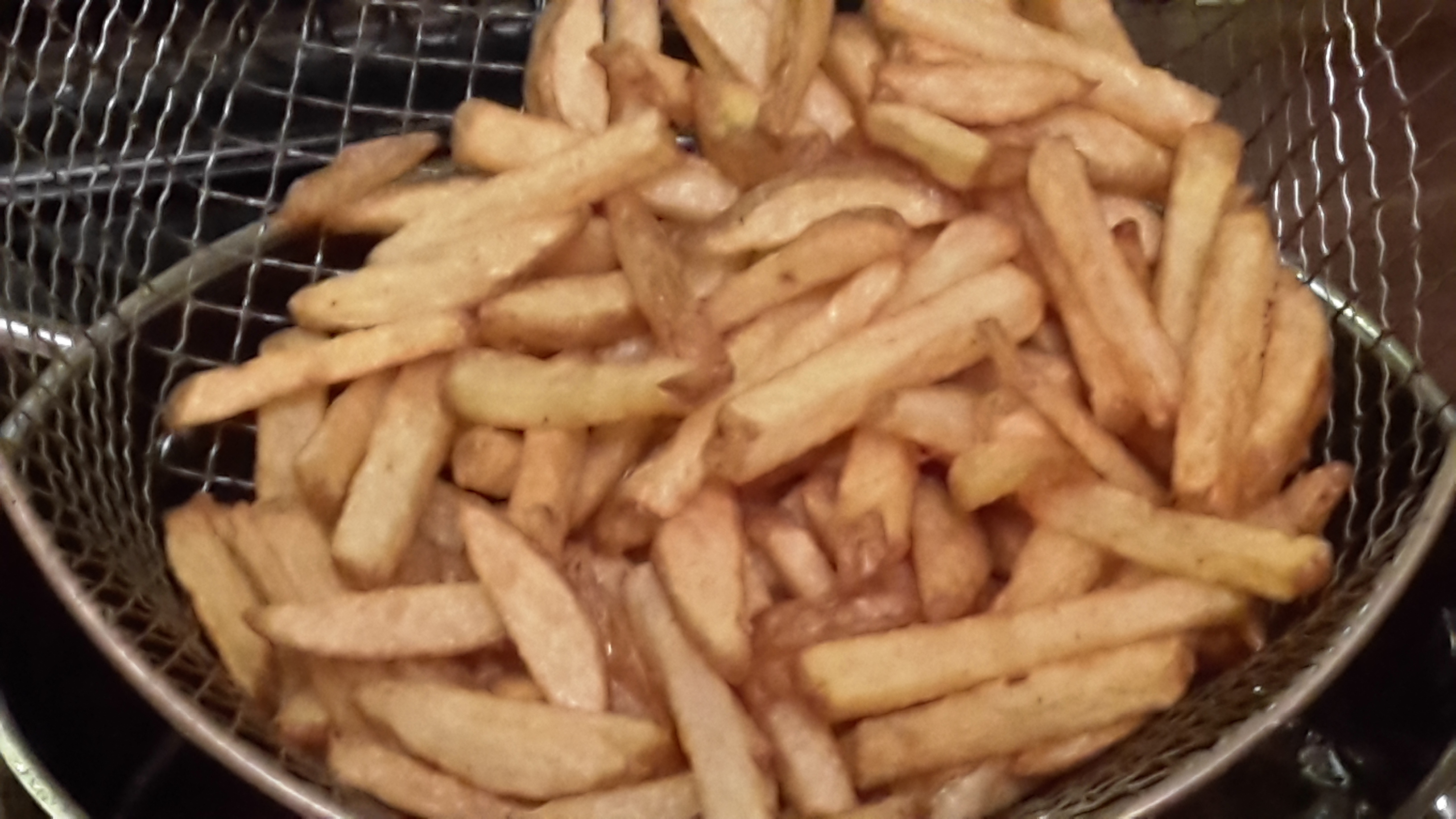These fermented foods are very rich in natural, living probiotics and yeasts which replenish our support system* by replenishing our gut bacteria and clearing out any rubbish (start eating them slowly, increasing over a week, and prepare for some interesting trips to the toilet!!)
Sauerkraut
You need:
an organic white or red cabbage, or half of each; about 1 tablespoon ground Himalayan salt
a large sturdy bowl, a sterilised medium sized kilner jar
Optional: you an add cumin seeds, black onion seeds, finely grated carrot, dill or other herbs, chilli flakes, mustard seeds, etc for flavour. Though I tend to stick with the basic recipe so I haven’t tried any of these!
Finely shred the cabbage and add to the bowl. Add the salt. Mix together with your hands, squeezing the cabbage between your hands, pushing down with your knuckles, and squeezing some more, to get as much juice out as possible. It should turn wet quite quickly, but keep doing this for a good few minutes.
Press down into the kilner jar, packing it full. As you press down you should notice it being covered with the juice. If not, squeeze it some more. Last resort you can add a small amount of water, though I tend not to. Cover with a muslin cloth and elastic band, like you would a jamjar and leave in a warm place in the kitchen, out of strong light. You can begin using the sauerkraut in a few days. Once it gets tasty, after about a week or so, remove the muslin top and close the jar and store it in the fridge. If it over ferments or becomes contaminated it may turn cheesy and smell like very strong cheesy old socks! That’s a sign to start again!
Making Water Kefir or Kombucha
Rules: use glass jars and bottles, use non metallic utensils, keep your cultures alive by leaving them in a small amount of liquid from the last batch until you want to use them again. Do not refrigerate the cultures. I bought organic kefir grains and SCOBYs on Ebay very reasonably (I also offer SCOBYs HERE) and they will last forever if you look after them!
The difference between the 2: Water kefir is very much a great general probiotic and has a host of bacteria to assist your gut flora balance. It also contains some enzymes and acid for assisting digestion. Kombucha is richer in the digestive enzymes and acids, while still having some probiotic bacteria for the gut flora. It can also still contain caffeine after fermentation.
Water Kefir
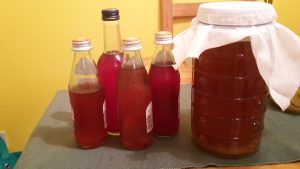
I love water kefir. When it has fermented just nicely, the unflavoured base tastes similar to appletiser, though it can be quite acidic. Then you can second ferment it with fruit and/or herbs to get lovely fizzy flavours and varieties. Have fun trying out and experimenting!
You will need: a 2L large wide necked glass jar, water kefir grains, bottles for bottling (I use old passatta jars for second ferment and small glass water bottles for bottling).
TO MAKE WATER KEFIR:
use 2 tablepoons white sugar, 1 tablespoon golden sugar and 1 tablespoon molasses to approx 1.5L filtered water and 4 tablespoons of kefir grains. You can experiment with the mix of sugars, but generally you need some molasses and I find this ratio works the best.
Dissolve the sugar into the water (it can take a while!) and once dissolved add to a 2L sterilised jar with the kefir grains. Cover with muslin cloth and secure with elastic band, and leave in a warm place out of direct light for about 3-5 days. After 3 days taste it, and each day after until you have a nice balance between sweet and sour. There may be some scum on top, just scrape it away and discard it. For second ferment see below.
Kombucha
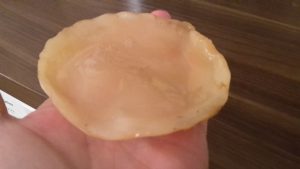
Kombucha as a high probiotic living fermented tea. It is made with a SCOBY (Symbiotic Culture Of Bacteria and Yeast).
SCOBYs feed best on black tea, though kombucha made solely with black tea can be very strong and vinegary! I find a mix of mainly green with just some black tea works best.
TO MAKE KOMBUCHA:
use 6 tea bags (unbleached, organic) to 1.5L water to 4 tablespoons sugar (can be unrefined, or mix as kefir – see what works best for you)
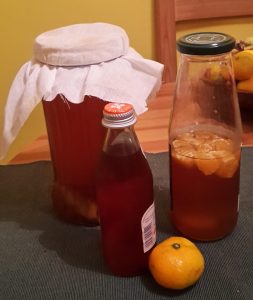
Boil the water and dissolve the sugar in, add the teabags and leave to brew until cool to the touch. Do not let hot water touch your SCOBY as it will kill it. Once the tea is cooled, add to the sterilised jar and place the SCOBY in with the darker side downwards. Cover with muslin cloth and elastic band, and put in a warm place out of direct light.
Kombucha takes approx 10 days to ferment. It will grow a new SCOBY each time you make a batch, so you can share this with friends and family! Keep spare SCOBYs in some of the fermented tea in an airtight container. Again, you will know when it is done by taste, find the balance between sweetness and sourness!
It took me a few attempts to get kombucha to not taste like vinegar! So don’t get frustrated, just try again! The taste will improve at second ferment so it is worth trying even if the first ferment is vinegary.
Second Ferment
To second ferment your unflavoured kombucha or water kefir, half fill some wide necked jars such as old passatta jars. I also use old wine bottles but you have to cut the fruit really small for these!
Add some chopped fruit. I find sliced apple, berries (can be frozen), satsuma (cut segments in half), freshly squeezed lemon juice and ginger (to make lemonade) and black grapes work best. But I haven’t tried everything and I am still experimenting! Top up with more unflavoured kombucha or water kefir if needed to about 3/4 full. Place lid on firmly.
Both will go fizzy on second ferment, water kefir more so than kombucha in my experience. You need to release the gas each day just by loosening the lid until it goes ‘pfft’ and securing it again. Both will take just a few days, again go by taste.
When it is ready, you can either serve it straight away after filtering out the fruit, or bottle it and refrigerate it for another day. Both will last about a week or more.
Kombucha can have a small alcohol content at certain ferments, and can taste a little like fruity cider. Though the last lot I did with satsuma tastes like healthy orangeade! Kefir tends to taste more like fruity fizzy pop. Sometimes the bottling process will kill the fizz, but some fizz will return after a few days in the fridge.
Milk Kefir
I love the milk kefir you can buy but yet to make some that I like the taste of. This is mainly because it turns very quickly from a creamy yoghurt taste to a very strong yoghurt taste and I keep missing that point!
You will need: Milk Kefir grains, whole organic milk (raw is best if you can get any)
add the milk kefir grains to approx 300ml milk. Cover with muslin cloth and band, leave in a warm place out of direct light. Leave for 24-48hours and then sieve the grains from the kefir into another jar or jug. Use the grains to make another batch, or keep them in a little milk in the fridge for next time. Store the made milk kefir in the fridge.
Sourdough
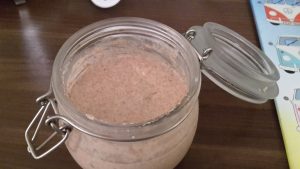 I have purchased some sourdough and currently feeding it and growing it. Once I begin using it I will post recipes and more information here!
I have purchased some sourdough and currently feeding it and growing it. Once I begin using it I will post recipes and more information here!
*formerly known as the immune system. Proven by the science of German New Medicine, we do not actually need to fight disease, so we do not have a defensive immune system as once thought, but rather a support system that supports our body functions and processes.

